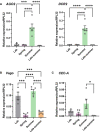Seasonality influences key physiological components contributing to Culex pipiens vector competence
- PMID: 38469495
- PMCID: PMC10926469
- DOI: 10.3389/finsc.2023.1144072
Seasonality influences key physiological components contributing to Culex pipiens vector competence
Abstract
Mosquitoes are the most important animal vector of disease on the planet, transmitting a variety of pathogens of both medical and veterinary importance. Mosquito-borne diseases display distinct seasonal patterns driven by both environmental and biological variables. However, an important, yet unexplored component of these patterns is the potential for seasonal influences on mosquito physiology that may ultimately influence vector competence. To address this question, we selected Culex pipiens, a primary vector of the West Nile virus (WNV) in the temperate United States, to examine the seasonal impacts on mosquito physiology by examining known immune and bacterial components implicated in mosquito arbovirus infection. Semi-field experiments were performed under spring, summer, and late-summer conditions, corresponding to historically low-, medium-, and high-intensity periods of WNV transmission, respectively. Through these experiments, we observed differences in the expression of immune genes and RNA interference (RNAi) pathway components, as well as changes in the distribution and abundance of Wolbachia in the mosquitoes across seasonal cohorts. Together, these findings support the conclusion that seasonal changes significantly influence mosquito physiology and components of the mosquito microbiome, suggesting that seasonality may impact mosquito susceptibility to pathogen infection, which could account for the temporal patterns in mosquito-borne disease transmission.
Keywords: Culex pipiens; RNAi; Wolbachia; gene expression; mosquito; physiology; seasonality; semi-field.
Copyright © 2023 Field and Smith.
Conflict of interest statement
The authors declare that the research was conducted in the absence of any commercial or financial relationships that could be construed as a potential conflict of interest.
Figures



Similar articles
-
Crossover Dynamics of Culex (Diptera: Culicidae) Vector Populations Determine WNV Transmission Intensity.J Med Entomol. 2020 Jan 9;57(1):289-296. doi: 10.1093/jme/tjz122. J Med Entomol. 2020. PMID: 31310655
-
Noncoding Subgenomic Flavivirus RNA Is Processed by the Mosquito RNA Interference Machinery and Determines West Nile Virus Transmission by Culex pipiens Mosquitoes.J Virol. 2016 Oct 28;90(22):10145-10159. doi: 10.1128/JVI.00930-16. Print 2016 Nov 15. J Virol. 2016. PMID: 27581979 Free PMC article.
-
Mosquito Microbiome Dynamics, a Background for Prevalence and Seasonality of West Nile Virus.Front Microbiol. 2017 Apr 4;8:526. doi: 10.3389/fmicb.2017.00526. eCollection 2017. Front Microbiol. 2017. PMID: 28421042 Free PMC article.
-
The contribution of Culex pipiens complex mosquitoes to transmission and persistence of West Nile virus in North America.J Am Mosq Control Assoc. 2012 Dec;28(4 Suppl):137-51. doi: 10.2987/8756-971X-28.4s.137. J Am Mosq Control Assoc. 2012. PMID: 23401954 Review.
-
Interactions between West Nile Virus and the Microbiota of Culex pipiens Vectors: A Literature Review.Pathogens. 2023 Oct 27;12(11):1287. doi: 10.3390/pathogens12111287. Pathogens. 2023. PMID: 38003752 Free PMC article. Review.
Cited by
-
Molecules to spillover: how climate warming impacts mosquito-borne viruses.Curr Opin Virol. 2025 Sep;72:101473. doi: 10.1016/j.coviro.2025.101473. Epub 2025 Jun 25. Curr Opin Virol. 2025. PMID: 40570812 Review.
References
Grants and funding
LinkOut - more resources
Full Text Sources

